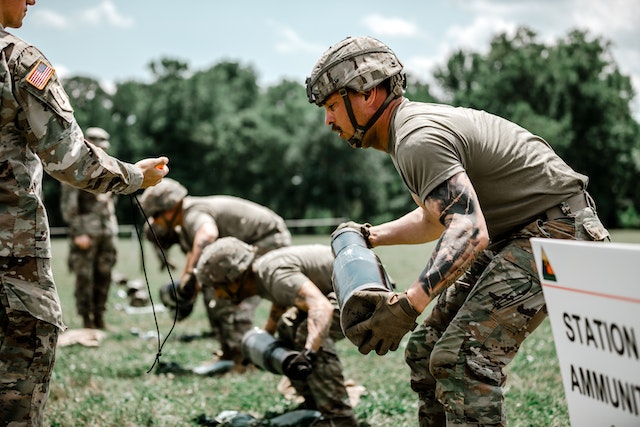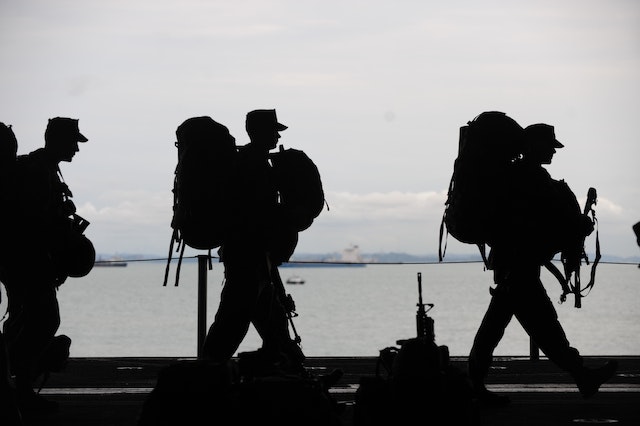To guarantee that troops are physically healthy and capable of executing their jobs efficiently, the US Army has important height and weight requirements in place. Determining a soldiers’s overall health and preparedness for military duty begins with height and weight standards. This article will discuss the significance of height and weight standards, the Army’s precise criteria, and the repercussions of noncompliance.
Looking to join the Army. Don’t forget you need to take the ASVAB test first. Start preparing now with our free ASVAB practice tests.
Importance of Height and Weight Requirements
Height and weight requirements are critical for keeping a well-prepared and effective military force. Soldiers must satisfy these criteria in order to meet the physical demands of their duties. Maintaining optimum height and weight boosts not just general fitness but also minimizes the danger of injuries, increases endurance, and assures optimal performance in combat scenarios.
Army Height And Weight Standards For Men (2024)
| Height of Men | Minimum Weight | Maximum Weight (from 17 to 20) | Maximum Weight (from 21 to 27) | Maximum Weight (from 28 to 39) | Maximum Weight (over 40 years old) |
| 58 inches | 91 pounds | N/A | N/A | N/A | N/A |
| 59 inches | 94 pounds | N/A | N/A | N/A | N/A |
| 60 inches | 97 pounds | 132 pounds | 136 pounds | 139 pounds | 141 pounds |
| 61 inches | 100 pounds | 136 pounds | 140 pounds | 144 pounds | 146 pounds |
| 62 inches | 104 pounds | 141 pounds | 144 pounds | 148 pounds | 150 pounds |
| 63 inches | 107 pounds | 145 pounds | 149 pounds | 153 pounds | 155 pounds |
| 64 inches | 110 pounds | 150 pounds | 154 pounds | 158 pounds | 160 pounds |
| 65 inches | 114 pounds | 155 pounds | 159 pounds | 163 pounds | 165 pounds |
| 66 inches | 117 pounds | 160 pounds | 163 pounds | 168 pounds | 170 pounds |
| 67 inches | 121 pounds | 165 pounds | 169 pounds | 174 pounds | 176 pounds |
| 68 inches | 125 pounds | 170 pounds | 174 pounds | 179 pounds | 181 pounds |
| 69 inches | 128 pounds | 175 pounds | 179 pounds | 184 pounds | 186 pounds |
| 70 inches | 132 pounds | 180 pounds | 185 pounds | 189 pounds | 192 pounds |
| 71 inches | 136 pounds | 185 pounds | 189 pounds | 194 pounds | 197 pounds |
| 72 inches | 140 pounds | 190 pounds | 195 pounds | 200 pounds | 203 pounds |
| 73 inches | 144 pounds | 195 pounds | 200 pounds | 205 pounds | 208 pounds |
| 74 inches | 148 pounds | 201 pounds | 206 pounds | 211 pounds | 214 pounds |
| 75 inches | 152 pounds | 206 pounds | 212 pounds | 217 pounds | 220 pounds |
| 76 inches | 156 pounds | 212 pounds | 217 pounds | 223 pounds | 226 pounds |
| 77 inches | 160 pounds | 218 pounds | 223 pounds | 229 pounds | 232 pounds |
| 78 inches | 164 pounds | 223 pounds | 229 pounds | 235 pounds | 238 pounds |
| 79 inches | 168 pounds | 229 pounds | 235 pounds | 241 pounds | 244 pounds |
| 80 inches | 173 pounds | 234 pounds | 240 pounds | 247 pounds | 250 pounds |
Army Height And Weight Standards For Women (2023)
| Height of Women | Minimum Weight | Maximum Weight (from 17 to 20) | Maximum Weight (from 21 to 27) | Maximum Weight (from 28 to 39) | Maximum Weight (over 40 years old ) |
| 58 inches | 91 pounds | 119 pounds | 121 pounds | 122 pounds | 124 pounds |
| 59 inches | 94 pounds | 124 pounds | 125 pounds | 126 pounds | 128 pounds |
| 60 inches | 97 pounds | 128 pounds | 129 pounds | 131 pounds | 133 pounds |
| 61 inches | 100 pounds | 132 pounds | 134 pounds | 135 pounds | 137 pounds |
| 62 inches | 104 pounds | 136 pounds | 138 pounds | 140 pounds | 142 pounds |
| 63 inches | 107 pounds | 141 pounds | 143 pounds | 144 pounds | 146 pounds |
| 64 inches | 110 pounds | 145 pounds | 147 pounds | 149 pounds | 151 pounds |
| 65 inches | 114 pounds | 150 pounds | 152 pounds | 154 pounds | 156 pounds |
| 66 inches | 117 pounds | 155 pounds | 156 pounds | 158 pounds | 161 pounds |
| 67 inches | 121 pounds | 159 pounds | 161 pounds | 163 pounds | 166 pounds |
| 68 inches | 125 pounds | 164 pounds | 166 pounds | 168 pounds | 171 pounds |
| 69 inches | 128 pounds | 169 pounds | 171 pounds | 173 pounds | 176 pounds |
| 70 inches | 132 pounds | 174 pounds | 176 pounds | 178 pounds | 181 pounds |
| 71 inches | 136 pounds | 179 pounds | 181 pounds | 183 pounds | 186 pounds |
| 72 inches | 140 pounds | 184 pounds | 186 pounds | 188 pounds | 191 pounds |
| 73 inches | 144 pounds | 189 pounds | 191 pounds | 194 pounds | 197 pounds |
| 74 inches | 148 pounds | 194 pounds | 197 pounds | 199 pounds | 202 pounds |
| 75 inches | 152 pounds | 200 pounds | 202 pounds | 204 pounds | 208 pounds |
| 76 inches | 156 pounds | 205 pounds | 207 pounds | 210 pounds | 213 pounds |
| 77 inches | 160 pounds | 210 pounds | 213 pounds | 215 pounds | 219 pounds |
| 78 inches | 164 pounds | 216 pounds | 218 pounds | 221 pounds | 225 pounds |
| 79 inches | 168 pounds | 221 pounds | 224 pounds | 227 pounds | 230 pounds |
| 80 inches | 173 pounds | 227 pounds | 230 pounds | 233 pounds | 236 pounds |
Army Height Requirements
Initial Entry Soldiers
Individuals interested in joining the Army must meet certain height standards. Men must be at least 60 inches (5 feet) tall, while women must be at least 58 inches (4 feet 10 inches). These requirements are in place to guarantee that prospective recruits have the physical characteristics required to withstand the rigors of military training.
Active Duty and Reserve Soldiers
Once enrolled, soldiers must maintain their height throughout their service. Active duty and reserve troops have no minimum height restrictions. Extreme height variances, whether too tall or too short, may impede a soldier’s ability to do specific activities and may restrict their career progression chances.
Officer Candidates
Officer candidates have somewhat differing height requirements than regular troops. Male candidates must be at least 58 inches (4 feet 10 inches) tall, while female candidates must be at least 56 inches (4 feet 8 inches). These criteria serve to guarantee that officers are physically capable of properly leading and engaging in military activities.
Army Weight Requirements
Maximum Allowable Weight
In addition, the Army has weight requirements to ensure that troops maintain a healthy body weight. Body Mass Index (BMI) calculations are used to develop these guidelines. The maximum permitted weight is determined by your age, gender, and height. Soldiers who surpass the maximum permissible weight are subjected to further body fat assessments.
Body Fat Guidelines
In addition to weight criteria, the Army assesses a soldier’s general fitness by measuring body fat percentage. The Army Body Composition Program (ABCP) is used to calculate body fat norms. Noncompliance with body fat norms may result in disciplinary action and even discharge from the military.
The Costs of Noncompliance
Soldiers who do not satisfy the Army’s height and weight requirements may face harsh penalties. Soldiers may face disciplinary procedures such as retraining, counselling, or even dismissal from the military depending on the degree of their noncompliance. To prevent these possible consequences, troops must maintain their physical condition and adhere to the prescribed requirements.
Adherence to Height and Weight Standards
Soldiers are urged to live a healthy lifestyle in order to meet height and weight criteria. Maintaining good physical health requires regular exercise, a balanced diet, portion management, and sufficient hydration. The Army offers tools and assistance to troops to help them reach these goals and live a healthy lifestyle.
Tips on Fitness and Nutrition
Consistent Exercise
Regular physical activity is essential for fulfilling height and weight requirements. Soldiers should engage in both aerobic and strength training routines to improve their overall fitness. Soldiers can improve their physical performance through activities such as weightlifting, running, calisthenics, and swimming.
Dietary Balance
Maintaining a healthy weight requires a well-balanced diet. Soldiers should eat a range of nutrient-dense meals, such as lean proteins, whole grains, fruits and vegetables, and healthy fats. Processed foods, drinks with high sugar content, and high fat snacks should be avoided to maintain optimal weight.
Portion Control
Controlling portion sizes is important in weight control. Soldiers should watch their portion amounts and avoid overeating. It is critical to balance calorie consumption with physical activity in order to achieve and maintain a healthy weight.
Hydration
Hydration is critical for overall health and performance. Soldiers should drink enough water throughout the day to avoid dehydration and to sustain body functioning. Staying hydrated also helps with hunger management and energy levels.
Final Thoughts
Maintaining height and weight requirements is an important part of military duty in the United States Army. Soldiers guarantee their physical preparedness and contribute to a robust and competent armed force by adhering to these requirements. Following fitness and nutrition guidelines, participating in regular exercise, and adopting healthy living choices are all necessary for completing these standards and advancing in your military career.
What happens if a soldier does not satisfy the height and weight requirements?
Soldiers who do not satisfy the height and weight requirements may face disciplinary procedures such as retraining, counseling, or dismissal from the service.
Are there any exemptions to the height and weight requirements?
On a case-by-case basis, exemptions to the height and weight requirements are granted. These exceptions are usually granted for medical reasons or special occupational needs.
Are troops eligible for help in fulfilling the standards?
Yes, the Army offers tools and assistance to help troops reach height and weight requirements, such as exercise programs and dietary advice.
How often are troops obliged to get their height and weight measured?
Soldiers are usually forced to have their height and weight measured once a year. However, depending on the conditions, more frequent measurements may be taken.
Can troops be fired if they fail to satisfy the standards?
Soldiers who fail to fulfill the height and weight criteria on many occasions and demonstrate no progress may be discharged from the service. Before resorting to separation, however, attempts are made to help and support troops in reaching these criteria.

